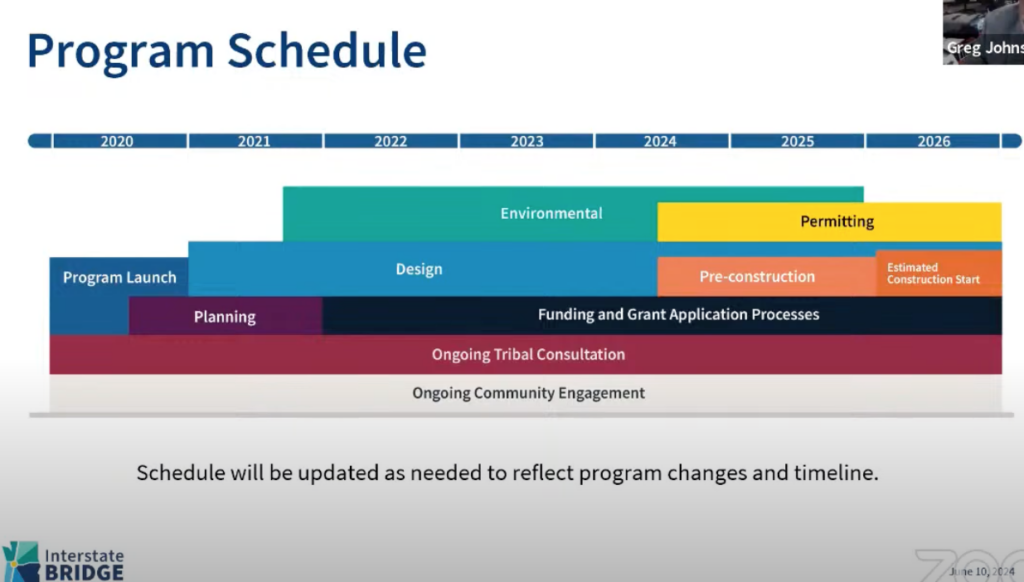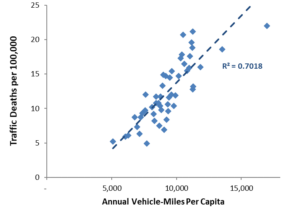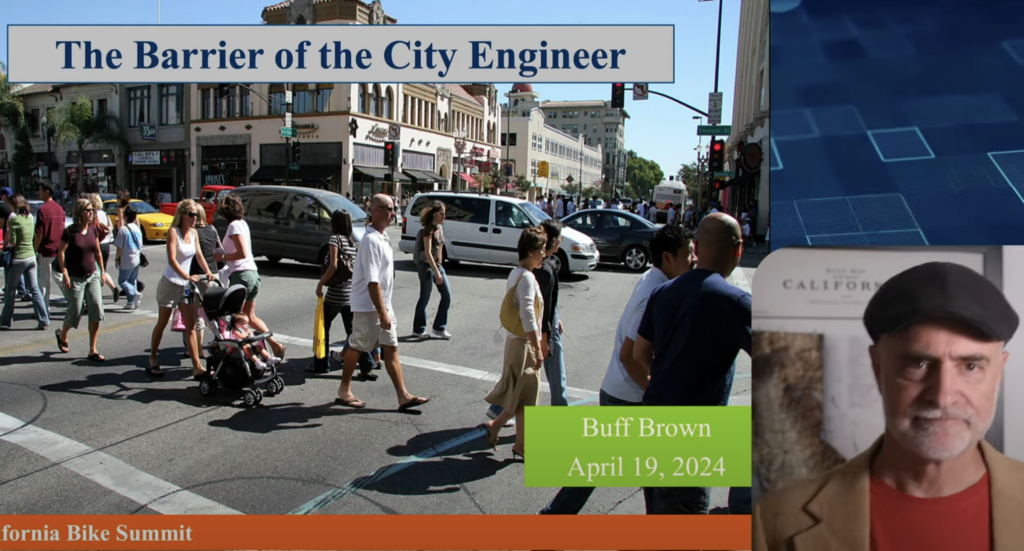What City Observatory Did This Week
The Oregon Department of Transportation’s (ODOT) Interstate Bridge Replacement (IBR) project is facing significant delays of up to 18 months. The culprit? Flawed traffic modeling that overestimates future traffic use.
City Observatory and others have long pointed up flaws in IBR’s traffic modeling, arguing it overestimates traffic growth and paints an inaccurate picture of project needs and environmental impacts. This week, IBR officials admitted that the federal government is demanding that they re-do the traffic projections–but what they haven’t acknowledged publicly is that this will delay the project for a year or more:
- The Issue: IBR’s traffic modeling is outdated and needs to be redone to satisfy the US Department of Transportation and also to comply with Metro’s recently adopted Regional Transportation Plan (RTP).
- IBR Knew About the Risk: Internal documents show IBR was aware of this potential delay for years but hoped to avoid it by rushing the environmental review process.
- Delays Confirmed: IBR now acknowledges the need to redo the modeling, causing delays of 6 to 18 months according to their own previously secret risk reports.
- Downplaying the Problem: Despite the delays, ODOT officials downplay the issue, vaguely claiming that they are “On track to . . a good path to get this project underway.”
- Transparency Concerns: IBR hasn’t released an updated project schedule reflecting the delays. The current schedule, from January 2024, is already outdated.
- Potential Project Reassessment: The new modeling is likely to show lower traffic needs, potentially impacting the project’s justification, size, and environmental assessments.
The “schedule” that IBR provided the the Legislature on June 10 is a paragon of obfuscation: it has deleted the previously quarterly timetable presented in earlier presentations, struck out any specific milestones (like issuing the draft environmental statement or starting construction), and put in a caveat that nullifies all of the supposed information in the chart (in essence saying the schedule will be changed as the schedule changes)
This massive project is over budget and behind schedule, and will certainly become moreso in the next few months, even as its staff and consultants flail to conceal these facts.
Must Read
Can Governor Hochul legally “pause” New York’s congestion pricing program? There’s been a firestorm of reaction to Governor Kathy Hochul’s unilateral declaration that the congestion pricing program scheduled to take effect in Manhattan on June 30 would be suspended. This is a vastly consequential decision, not just for New York, but for urbanism nationally. Congestion pricing in the Big Apple would be a watershed demonstration of the efficacy of this powerful tool to dramatically change urban transportation for the better. Law professor Rick Hills concludes that the New York Governor actually doesn’t have the authority to abort the program. His detailed legal analysis concludes that “the state congestion pricing statute deliberately carved the governor out of any role in implementing the congestion pricing system.” That has led the Governor to lean on an implied opportunity to veto the program under federal rules. Hills argues that this is a legally flawed and dangerous argument:
Hochul’s use of this alleged power — a power to withhold a signature from a document that has already been approved by every statutorily specified stakeholder and that no written law says is even legally necessary—is just more democracy-killing vetocracy at its intergovernmental worst.
Much is riding on the fate of congestion pricing. Advocates are planning to challenge Hochul in court. We should know the outcome in the next few weeks. Stay tuned.
The title Wes Marshall’s new book, “Killed by a traffic engineer” leaves no doubt about the author’s message. Marshall documents the profound biases and superficial education and scholarship of the engineers we’ve empowered to make crucial decisions about road safety. The book is a must read, as is Todd Litman’s Planetizen book review. Litman amasses an array of statistics that relentlessly buttress Marshall’s case. Highway engineers have concocted “per mile traveled” safety measures that inherently downplay the biggest single risk factor of the transportation system: how much we drive. As Litman summarizes:
This is a key point in Marshall’s book: conventional transportation engineering often evaluates traffic risk using distance-based metrics such as collisions, casualties, or deaths per 100 million vehicle-miles or million vehicle-trips. Such indicators ignore exposure as a risk factor and so fail to recognize the additional crashes that result from planning decisions that increase per capita vehicle travel or the safety benefits of vehicle travel reductions.
Litman’s review lays out some great statistics making this essential point: More driving produces more crashes, more injuries, more deaths.
If you’ve already read Marshall’s Killed by a traffic engineer, Litman’s review is a great dessert; if you haven’t read Marshall yet, it’s a great appetizer. Either way, you’ll want to read both.
Rapping on traffic safety: Our friend, engineer Buff Brown shows hidden depths in his rap on the common fallacies that underly much of engineering practice for traffic safety. This can be a dry, technical subject, but Brown covers a lot of ground in an entertaining way. Titled “The Barrier of the City Engineer, Brown recounts and refutes the excuses engineers routinely use for not making streets safer.
His video is a great corrective for those of us who have had to sit through one too many powerpoint presentations. We’ll file this next to Paul Rippey’s folk song ‘The Ballad of Induced Demand.” Give it a watch.
In the News
The Daily Journal of Commerce noted Joe Cortright’s testimony to the Joint Oregon-Washington legislative committee on the I-5 bridge, pointing out that the project is over budget, behind schedule and based on demonstrably flawed traffic projections.
The Portland Oregonian quoted Joe Cortright in its article on declining traffic levels across the Columbia River on I-5 and I-205. Traffic is down by 15,000 vehicles from pre-pandemic levels, and shows no signs of growing as fast as it did in th past–contradicting highway department projections that growth will accelerate.



